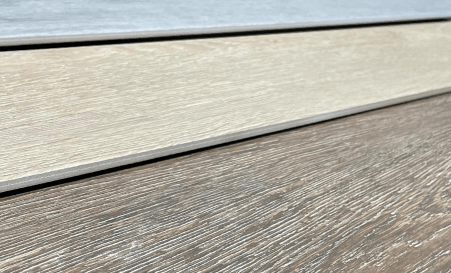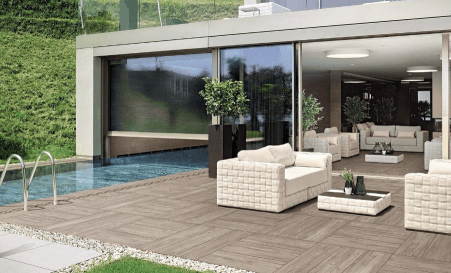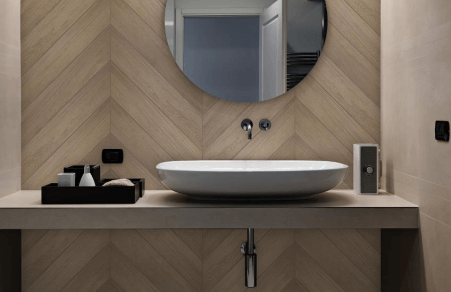Timber flooring throughout the home offers a timeless and elegant look. There are many different species of timber available to choose from as well as a range of customizable timber stains and sheen levels to help you achieve the perfect colour palette in your home. Tiles are another popular solution for the home, however, offering a vast range of exciting benefits and style options.
With the rise in popularity of timber-look tiles, it is definitely worth spending a little extra time during the colour and material selection process to weigh up the benefits of each option and decide which is best for your needs and style preferences.
What are Timber Look Tiles?
Timber look tiles are most often made of porcelain which is famous for its incredible resistance to scratching, moisture and staining, making porcelain a popular choice for the home. These tiles feature a timber look pattern complete with textures and colour variations to simulate the look and feel of natural timber. Designs are printed onto the tile’s surface using digital ink technology achieving an incredibly realistic representation of timber. You will find an impressive range of timber look tile options available, from classic parquetry style options, glossy or matte designs, and even more rustic options that feature a whitewash look or a distressed timber finish.

Tiles vs. Timber in Wet Areas
Although natural timber flooring has long been a popular solution for a home’s interiors, it is most often avoided in wet areas such as the bathroom for example where the increased levels of humidity and moisture can lead to warping, swelling, or even mold in the timber. Furthermore, due to the nature of these spaces, messes, and spills can be inevitable, making natural timber cumbersome to upkeep and maintain.

Tiles on the other hand are a traditional flooring solution in wet areas of the home such as the laundry and bathroom thanks to their ability to withstand humidity and moisture. Tiles can be easier to clean and maintain, making them an excellent choice in these areas. Although they will not be affected by the conditions of wet spaces of the home, it is important to take note of the type of material your tiles are made from and ensure proper care and cleaning procedures are used that are specific to these materials. Natural stone tiles for example will require sealing every year to ensure they are protected against staining or watermarks. These tiles must also be kept clean with specific tile cleaning products that are gentle enough not to disrupt their sealed surface or cause damage to the material itself. As timber look tiles are most commonly made of sturdy porcelain material, there is no need for continued sealing as the material is non-porous and will not absorb spills or moisture, making timber look tiles ideal for wet areas thanks to their low
maintenance qualities as well as their warm, characteristic look that offers a wonderful alternative solution to natural timber.
The Differences between Timber Look Tiles & Real Timber
These are two completely different materials however, each offers the same look and texture of traditional timber in the home. Hardwood flooring will create a sense of warmth and timeless charm throughout your interior spaces however, as noted above this material is best avoided in wet areas of the home such as the bathroom and laundry. Timber look tiles however offer a wonderful alternative solution that can be comfortably installed in these humid environments.

A common concern when it comes to using timber look tile in place of traditional timber is the material’s temperature underfoot. Natural timber flooring will feel warmer whereas tiles will, of course, be cooler. There are solutions designed to work around this issue, however; underfloor heating can be installed along with your new floor tiles to bring warmth and comfort to your home. Underfloor heating works with heated coils being installed either in the concrete slab beneath your tiles or the beneath the tiles themselves
(given the tiles are suited to this application). The temperature can be controlled and you can even set a timer so that the heating system only activates at certain times that are most convenient for your lifestyle and needs.
Unlike natural timber flooring, porcelain timber tile flooring is scratch resistant with correct use. Your tiled floors will not show up anywhere near as much wear or marking as natural timber would and as a result, will not require re-sanding or polishing.
The key difference between these two stylish flooring options, however, is their realism; after all, timber tiles are a simulation of the real thing! If you are planning to include timber look tiles in your home, it is important to seek out a tile collection that includes a high amount of variation in colour and texture as this will offer the most realistic look in your project. Of course, real timber flooring is incredibly popular however, the many benefits provided by timber look tiles allow for more flexibility and design choice when it comes to creating a stylish yet low maintenance look in your next interior design project.










